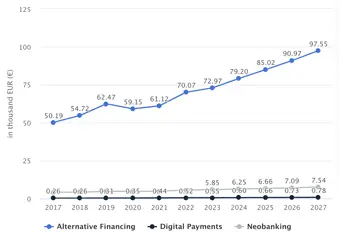Financial Industries in Southeast Asia vs. the United States
The financial industry is now the pillar industry of many countries, and the economic profits are relatively large. However, the pace of financial development is different between each country. So what are the differences between the financial industry in Southeast Asia and the United States?
Main Differences Between Southeast Asia and United States

1. Regulatory Framework:
In the United States, the regulatory system and agencies for the financial industry, including internet finance, are well-established. They focus on safeguarding personal property and privacy and maintain a relatively robust and comprehensive framework. The laws and regulations within this system harmonize well with each other, providing a stable and orderly environment for the development of internet finance.
In Southeast Asia, recent guidance on internet finance regulation has been released, and the specific implementation and effectiveness are still under development. The regulatory framework for financial industry in Southeast Asia is in a state of evolution. It's worth noting that the regulatory landscape in Southeast Asia can vary significantly from one country to another due to the region's diversity.
2. Economic Structure:
In the United States, influenced by regulatory policies and bodies, the technology and finance industries operate in a more orderly and balanced manner within a larger market environment. The degree of freedom in market resource allocation is relatively high. The U.S. financial industry is characterized by a highly developed and mature ecosystem, with various sectors of the financial market functioning cohesively.
In Southeast Asia, while internet finance has seen rapid growth in recent years, it still faces imbalances in its status compared to other industries. Further adjustments are needed to balance the economic structure in the market. Southeast Asian countries often vary in terms of economic development and the maturity of their financial industries, with some countries being more advanced in their financial services sector than others.
3. Financial Markets:
In the United States, financial and internet finance have already converged, mutually supporting the development of the financial industry. The United States boasts a well-integrated financial market where technology and traditional finance seamlessly coexist.
In Southeast Asia, internet finance and traditional finance are currently undergoing adjustment, and competition between the two is intense. The development potential and demand for internet finance are significant, and reforms in the traditional financial industry are underway, making convergence between the two a likely future trend. Southeast Asian countries are at various stages of integrating internet finance into their financial markets, with differing levels of competition and cooperation between traditional and tech-driven financial services.
Differences in the "Efficiency" of Securities Markets

Securities brokerage firms are essential intermediary institutions in the Southeast Asian securities market, serving as bridges and links in capital markets. The role and significance of securities brokerage companies in Southeast Asian markets are becoming increasingly crucial in the context of globalization.
The previously relatively closed system of Southeast Asian securities markets has been gradually opening up, allowing foreign securities institutions to establish a presence within Southeast Asia based on the principle of national treatment, engaging in relevant business operations. This opening up of the securities market has led to increased competition and diversity in the types of services offered to investors.
Competition Pressure on Southeast Asian Securities Companies
According to the Securities Law in most countries in Southeast Asia, securities companies are divided into comprehensive and brokerage categories, forming a dual structure. Comprehensive securities companies have certain advantages in terms of capital and assets, and they are at the core of Southeast Asian securities companies. These comprehensive firms often play a significant role in shaping the Southeast Asian securities landscape.
Given the concentration of business in a few comprehensive securities companies within the dual structure, it's crucial to study their corporate governance structures and identify gaps compared to their outside counterparts, particularly in the United States. In the pursuit of enhancing market efficiency, Southeast Asian regulatory authorities are exploring measures to promote competition and ensure equitable market access for both regional and global securities firms.
Comparative Analysis with US Securities Companies:
In the context of this dual structure in Southeast Asia's securities industry, a comparative study with US securities companies is highly relevant and could provide valuable insights. Such an analysis would help identify areas where Southeast Asian securities companies may need to enhance their governance structures and practices based on international comparisons, including those with U.S. firms. Understanding the strengths and weaknesses of the governance structures in place in the United States can serve as a benchmark for Southeast Asian firms to improve their corporate governance, risk management, and overall market efficiency.
Policies to Deal with Financial Crises

Financial crises can have severe implications for the stability of financial markets and the broader economy. Policymakers in both Southeast Asia and the United States have developed a range of measures to mitigate the impact of financial crises. Let's explore some of the key policies and strategies employed by these regions:
1. Regulatory Reforms
Both Countries in Southeast Asia and the United States have implemented regulatory reforms to enhance the resilience of their financial systems. This includes strengthening capital requirements for financial institutions, improving risk management practices, and enhancing regulatory oversight.
2. Monetary Policy
Central banks in both regions have the authority to implement monetary policy measures to stabilize the economy during a financial crisis. These measures may include interest rate adjustments, open market operations, and liquidity support to financial institutions.
3. Fiscal Stimulus
Governments may introduce fiscal stimulus packages to boost economic activity during a crisis. These packages can include tax cuts, infrastructure spending, and direct financial assistance to individuals and businesses.
4. Bank Bailouts
In the face of a systemic banking crisis, governments may intervene by providing financial support to troubled banks. This can involve capital injections, loan guarantees, or outright nationalization of failing institutions.
5. International Cooperation
Given the interconnectedness of global financial markets, international cooperation is critical in managing financial crises. Both Southeast Asian countries and U.S. authorities collaborate with international organizations and other countries to coordinate responses to crises and prevent their spread.
6. Deposit Insurance
Both regions typically have deposit insurance schemes to protect depositors in case of bank failures. These schemes provide a safety net to maintain confidence in the banking system.
7. Market Interventions
Authorities may intervene in financial markets to stabilize asset prices and prevent panic selling. This can include measures such as circuit breakers, trading halts, and market liquidity support.
8. Stress Testing
Regulatory authorities conduct stress tests on financial institutions to assess their resilience to adverse economic scenarios. This helps identify potential vulnerabilities and enables preventive action.
9. Communication and Transparency:
Effective communication by central banks and regulatory authorities is crucial during a financial crisis. Timely and transparent communication helps to manage market expectations and reduce uncertainty.
Final Thoughts
It's important to note that the specific policies and strategies employed may vary between Southeast Asian countries and the United States, reflecting differences in the structure of their financial systems, regulatory frameworks, and economic conditions. Additionally, the response to a financial crisis is highly contingent on the nature and severity of the crisis itself. Policymakers in both regions continuously adapt and refine their approaches to address the evolving challenges in the financial industry.
Aniday's HR Services
Headhunting Service
Find and recruit quality candidates in just 1 week! Supported by 40,000 experienced headhunters in IT, Finance, Marketing… capable of recruiting in any region.
Headhunting Service ➔Employer of Record (EOR) Service
On behalf of your business, we recruit employees and handle payroll without the need to establish a company in markets such as Vietnam, Singapore, Malaysia, India, Indonesia…
Employer of Record (EOR) Service ➔